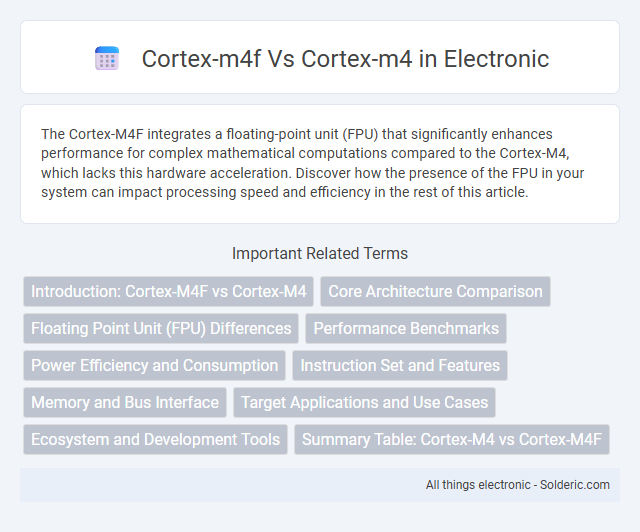The Cortex-M4F integrates a floating-point unit (FPU) that significantly enhances performance for complex mathematical computations compared to the Cortex-M4, which lacks this hardware acceleration. Discover how the presence of the FPU in your system can impact processing speed and efficiency in the rest of this article.
Comparison Table
| Feature | Cortex-M4 | Cortex-M4F |
|---|---|---|
| Core Type | ARM Cortex-M4 | ARM Cortex-M4 with Floating Point Unit (FPU) |
| Floating Point Unit | No FPU | Single-precision FPU (IEEE 754 compliant) |
| Performance | Fixed-point signal processing | Enhanced with hardware floating-point acceleration |
| Instruction Set | Thumb-2 | Thumb-2 + FPU instructions |
| Use Cases | General embedded applications | Real-time DSP and control applications needing floating point |
| Power Consumption | Lower (no FPU) | Higher (FPU active) |
Introduction: Cortex-M4F vs Cortex-M4
The Cortex-M4F processor integrates a single-precision Floating Point Unit (FPU), enhancing performance for DSP and control applications requiring fast arithmetic calculations compared to the Cortex-M4. Both cores support features like the Harvard architecture and DSP instructions, but the M4F's hardware FPU delivers up to 4x faster floating-point operations. This difference makes the Cortex-M4F ideal for real-time processing tasks in automotive, industrial, and consumer electronics where floating-point-intensive computations are critical.
Core Architecture Comparison
The Cortex-M4F features a 32-bit ARMv7-M architecture with an integrated single-precision Floating Point Unit (FPU), enhancing performance in DSP and control applications compared to the Cortex-M4, which lacks an FPU. Both cores support the Thumb-2 instruction set, but the M4F's FPU reduces software floating-point overhead, resulting in faster math computation and lower power consumption. This architectural upgrade makes the Cortex-M4F ideal for complex signal processing tasks in embedded systems requiring efficient real-time processing.
Floating Point Unit (FPU) Differences
The Cortex-M4F features a hardware Floating Point Unit (FPU) that significantly accelerates floating-point arithmetic, providing enhanced performance for DSP and control applications compared to the Cortex-M4, which lacks this dedicated FPU. With the integrated FPU in the Cortex-M4F, Your computations involving single-precision floating-point operations execute more efficiently, reducing CPU load and increasing overall system throughput. This makes the Cortex-M4F ideal for applications requiring high-precision mathematical calculations, such as motor control, audio processing, and embedded signal processing tasks.
Performance Benchmarks
The Cortex-M4F outperforms the Cortex-M4 by integrating a single-precision floating-point unit (FPU), significantly boosting performance in math-intensive applications by up to 50% in certain DSP and control algorithms. Benchmark tests show the Cortex-M4F achieves faster execution of floating-point operations and reduced cycle counts for complex calculations compared to the Cortex-M4, which relies solely on software-based floating-point emulation. When your project demands high computational efficiency and real-time processing, the Cortex-M4F offers clear advantages in performance benchmarks over the traditional Cortex-M4.
Power Efficiency and Consumption
The Cortex-M4F integrates a single-precision floating-point unit (FPU), enhancing computational efficiency while maintaining low power consumption compared to the Cortex-M4. Its optimized architecture reduces instruction cycles for complex math operations, leading to improved power efficiency during DSP and control applications. If your project demands intensive floating-point calculations with minimal energy use, the Cortex-M4F offers a clear advantage in power management over the standard Cortex-M4.
Instruction Set and Features
The Cortex-M4F integrates the ARMv7-M instruction set with single-precision floating-point unit (FPU) support, whereas the Cortex-M4 lacks hardware-based floating-point capabilities, relying solely on fixed-point instructions. The M4F enhances digital signal processing (DSP) features by accelerating complex mathematical calculations through its FPU, improving performance in applications like motor control and audio processing. Both cores share instruction set compatibility, but the Cortex-M4F's floating-point instructions enable faster execution of floating-point arithmetic than the pure integer operations of the standard Cortex-M4.
Memory and Bus Interface
The Cortex-M4F integrates a single-precision floating-point unit (FPU) that enhances its internal bus interface efficiency, enabling faster data transfers compared to the Cortex-M4. Both processors utilize an AMBA 3 AHB-Lite bus interface, but the Cortex-M4F supports higher memory bandwidth optimized for floating-point operations. This results in improved memory access performance, particularly beneficial for applications requiring intensive computational workloads and real-time processing.
Target Applications and Use Cases
The Cortex-M4F processor, equipped with a floating-point unit (FPU), excels in digital signal processing and control applications requiring high computational efficiency, such as motor control, audio processing, and industrial automation. In contrast, the Cortex-M4 without FPU targets cost-sensitive embedded systems where fixed-point arithmetic suffices, including simple consumer electronics and basic sensor management. The inclusion of the FPU in Cortex-M4F enables faster and more precise mathematical operations, making it suitable for applications demanding enhanced numerical performance.
Ecosystem and Development Tools
The Cortex-M4F distinguishes itself from the Cortex-M4 by integrating a hardware floating-point unit (FPU), which significantly enhances performance in mathematical computations, thereby influencing the tooling ecosystem to provide optimized libraries and compilers that leverage this feature. Development tools such as Keil MDK, IAR Embedded Workbench, and GCC support both cores, but the Cortex-M4F benefits from specialized DSP and FPU libraries that accelerate signal processing applications. Ecosystem compatibility extends to RTOS and middleware that are increasingly optimized for floating-point operations on Cortex-M4F, facilitating efficient development workflows for complex embedded systems.
Summary Table: Cortex-M4 vs Cortex-M4F
The Cortex-M4F features a single-precision floating-point unit (FPU) that significantly enhances performance for DSP and control applications compared to the Cortex-M4, which lacks an FPU. Both processors share a 32-bit ARMv7-M architecture with similar core speeds, interrupt handling, and memory interfaces, but the M4F's hardware FPU reduces computational latency for floating-point math. Power consumption remains comparable, yet the M4F enables more efficient processing in embedded systems requiring complex mathematical operations, making it ideal for audio, motor control, and industrial automation tasks.
cortex-m4f vs cortex-m4 Infographic

 solderic.com
solderic.com